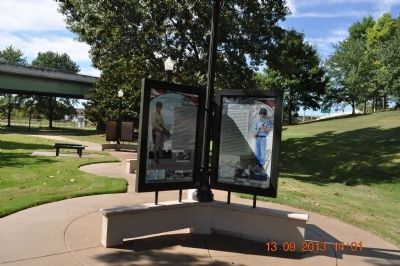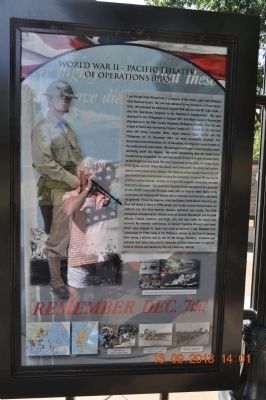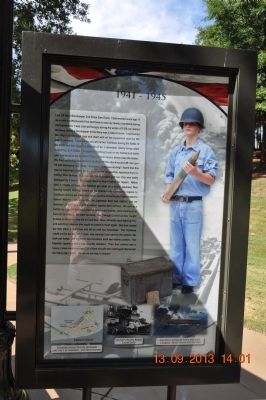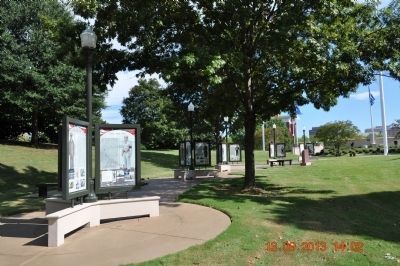Huntsville in Madison County, Alabama — The American South (East South Central)
World War II - Pacific Theater of Operations (PTO)
1941- 1945
Inscription.
I am Private Peter Pirnat from C Company of the 192nd Light Tank Battalion, Ohio National Guard. My unit was stationed in my hometown of Port Clinton, Ohio. We activated for training in August 1940 with our new M3 Light Tanks. I was the Operations Sergeant in the Battalion’s Headquarters. We were deployed to the Philippines in August 1941 and Major General Wainwright attached us to the 26th Cavalry Regiment (Philippine Scouts). This unit was unique in that it was manned by Filipino Troops who were in the US Army and were still horse mounted. When Japan attacked Pearl Harbor and the Philippines on 7-8 December 1941, we were completely shocked! The devastation was tremendous. On 18 December, the Imperial Forces landed on the north end of Luzon Island. We deployed and fought a long delaying action retreating south to Bataan. We knew immediately that we would have trouble being resupplied. Our unit had the US Army’s first tank on tank battle as we fought our way back. We were supported by the Army Air Corps flying P-35 fighter aircraft. When the planes were destroyed, the pilots and maintenance crews joined us as infantry. Our delaying action bought time so the US and Allied forces could prepare to stop the Japanese conquest. We had no US or Allied reinforcements. Finally, on 9 April with supplies exhausted, we were ordered to surrender.
The Japanese Imperial Forces marched us to a prisoner of war (POW) camp over 80 miles away with no food or water. Many of the Americans and Filipinos fell behind due to sickness and starvation and were slaughtered. Those five days we called the Bataan Death March. Few of us can even talk about it. Once in POW camps, just muddy unclean fenced areas, we suffered and died from wounds, disease, starvation and cruelty. The POW population included senior officers such as General Wainwright and his staff officers, Chabot, Johnson and Pugh, who had also made the march and survived. My battalion commander, Lt Colonel Theodore Wickord, and many others were shipped to Japan and used as laborers. I was liberated from Cabanatuan #1 POW camp in the Philippine Islands on the 31st of January 1945 during a brilliant raid by the US 6th Ranger Battalion. Freedom was welcome, but I have many painful memories of those three years of captivity. I tried to refocus and rebuild my life, but it was very difficult.
1941-1945
I am US Navy Storekeeper 2nd Class Sam Dunn. I had worked since age 11 as a clerk in a Woolworth Five and Dime to ease my family’s hardship during the Depression. I was cold and hungry during the winter of 1938, so I joined the Navy. Being a storekeeper in the Navy was a natural move. I maintained the ship’s stores, kept logs and dealt with all the equipment used
by the ship’s stores. I was on the aircraft carrier Yorktown during the Battle of Coral Sea that began on May 4th of ’42. I remember clearly being called to BATTLE STATIONS. I dropped everything to put on my helmet and battle gear and raced to the Number 2 Gun, a 3-inch mount, where I was the loader. We fired exploding rounds to try to drive off the attacking aircraft. Our guns hit and destroyed two “Betty” bombers. That was exciting! I heard that this was an important victory for us, because we stopped the Japanese from invading New Guinea. But, we lost the Lexington and our ship was badly damaged by a bomb. We limped back to Pearl Harbor for repairs. Within only a couple of days, our Admiral got wind of a major Japanese fleet moving toward Midway Island, so he ordered only emergency repairs to Yorktown and we set sail to join other carriers of the Pacific Fleet headed to defend Midway. On June 4th, the Japanese fleet was sighted and we launched all our fighters and bombers against their carriers. We were in a hellish air attack! Plane-launched torpedoes and bombs were coming at us from all directions. We were hit badly. Our Damage Control parties fought to keep us afloat as they did at Coral Sea. Now, all hands were fighting fires and patching holes so she might be towed to Pearl again. Bad luck sealed our fate when a Japanese sub hit us with two torpedoes. The Yorktown could not be saved. On 7 June, she capsized and went to the bottom. We took our lumps, but Yorktown dive-bombers sank two enemy carriers. The Imperial Japanese Navy was soundly defeated. Their four carriers and a heavy cruiser were sunk and 228 of their aircraft were destroyed. We turned the tide in the Pacific. We are on our way to victory!
Erected 2013.
Topics. This memorial is listed in this topic list: War, World II. A significant historical date for this entry is January 31, 1945.
Location. 34° 44.112′ N, 86° 35.327′ W. Marker is in Huntsville, Alabama, in Madison County. Memorial is at the intersection of Monroe Street Northwest and Monroe Street Northwest, on the left when traveling east on Monroe Street Northwest. Located along Patriots Walkway in Veterans park. Touch for map. Marker is at or near this postal address: 200 Monroe St NW, Huntsville AL 35801, United States of America. Touch for directions.
Other nearby markers. At least 8 other markers are within walking distance of this marker. ETO 1939-1945/PTO 1941-1945 (here, next to this marker); World War II - European Theater of Operations (ETO) (here, next to this marker); Korean War/1950-1953 (a few steps from this marker); Cold War-Global 1945-/ Cold War-Germany 1945-1990 (a few steps from this marker); Gulf War-1991/War on Terrorism (a few steps from this marker); 1959-1975/Vietnam War/Vietnam War (a few steps from this marker); Korean War / Cold War-Korea 1953- (a few steps from this marker); Spanish American War 1898/Philippine Insurrection 1899-1913 (a few steps from this marker). Touch for a list and map of all markers in Huntsville.
Credits. This page was last revised on June 16, 2016. It was originally submitted on January 26, 2014, by Sandra Hughes Tidwell of Killen, Alabama, USA. This page has been viewed 976 times since then and 43 times this year. Last updated on July 20, 2015, by J. Makali Bruton of Accra, Ghana. Photos: 1, 2, 3, 4. submitted on January 26, 2014, by Sandra Hughes Tidwell of Killen, Alabama, USA. • Bernard Fisher was the editor who published this page.



